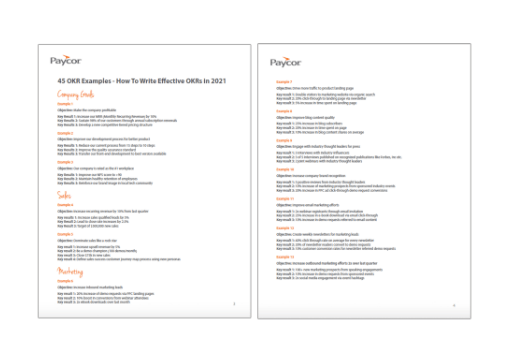Get examples and tips for writing OKRs
Are you looking to align employee priorities within teams and throughout your company? Start by creating effective OKRs.
Before you can succeed, you need to define success. The best way to drive business results and boost employee engagement is to set clear goals for your whole company. That’s why so many leaders build their strategies around objectives and key results (OKRs). In today’s business world, OKRs are the best practice for committing to goals and following through on them. If you’re just learning about OKR methodology, this guide can help you get started.
We’re going to tell you everything you need to know about how to write great OKRs. Better yet, we’re offering 45 OKR examples for you to use as inspiration.
What is the OKR Methodology?
The OKR methodology is a system for setting, communicating, and achieving goals throughout your company. OKRs translate your long-term strategies into bite-sized quarterly action items. When employees can accomplish specific short-term goals, they feel a sense of achievement that improves engagement and job satisfaction. Over time, those quarterly OKRs add up to long-term business success.
OKRs also create transparency, breaking down silos between teams and individual contributors. They empower employees to take ownership of specific projects and work more efficiently. Perhaps most importantly, OKRs create alignment across the entire company.
What Do OKRs Include?
Every OKR should consist of an objective and three to five corresponding key results.
The objective is an outcome that reflects current company, department, or personal priorities. Most objectives relate to the big picture and move your company toward long-term goals.
Each key result should answer the question, “How do I know if I achieved my objective?” These aren’t processes; they’re the end result of a specific series of tasks. Key results must be measurable.
Example OKR
Objective: Create more transparency across the organization by the end of FY25 by achieving these key results:
Key Results:
- Increase employee satisfaction rate for transparency by 25% as measured by a quarterly Pulse survey.
- Implement OKR methodology with 100% of employees creating an objective.
- Achieve 80% participation in weekly OKR check-ins between leaders and employees.
The objective in this example is challenging – as it should be. The key results represent different components of the objective. Each one indicates an essential milestone you need to reach before you can achieve the overarching goal.
Pro tip: Don’t confuse key results with tasks. Tasks are actions that employees perform to achieve key results.
How to Choose an OKR Alignment Model
When used effectively, OKR methodology aligns individual objectives with high-level company goals. When workers can see how their work drives business success, employee engagement goes up, bringing productivity levels with it.
To get the full benefits of OKR methodology, you’ll need to use the right alignment model for your company. These are the two most common OKR alignment models:
Cascading OKRs
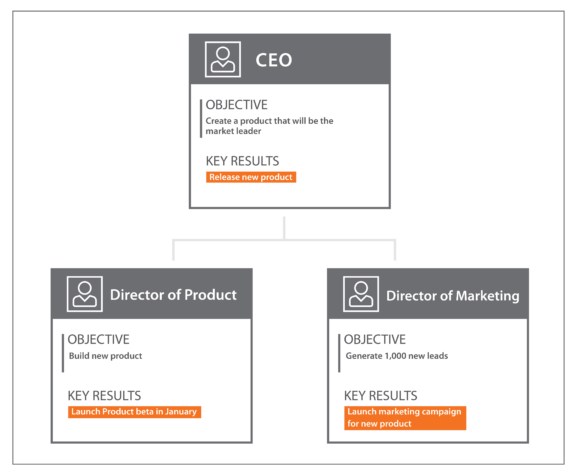
In this top-down model, each person’s OKRs cascade down to define the OKRs of their direct reports. This model typically works well for large companies or departments with well-established corporate hierarchies.
Aligning OKRs
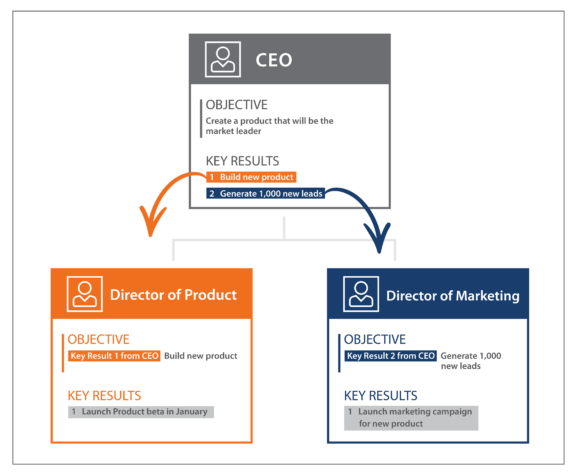
This model allows for greater flexibility, making it more effective for startups and smaller teams. Each department sets its internal OKRs, including individual OKRs for every person on the team. These goals should align with the overarching company objectives, but they don’t need to directly support every key result.
Setting a Cadence for OKRs
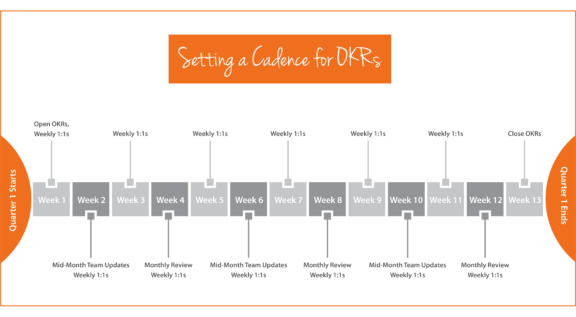
OKRs are time-limited, meaning they have start and end dates. You can decide how long that time period lasts. Most organizations use a quarterly cadence, meaning that every OKR runs for three months. You could also set OKRs that run for the fiscal year or another time period that makes sense in your industry. In an academic setting, for instance, you could set OKRs that run for the length of the school year.
Whatever time period you choose, make sure to schedule regular check-ins between employees and managers throughout that time. Leaders should implement internal processes – like weekly one-on-ones or team meetings – to offer proactive support and keep the team on track.
How to Define Company OKRs
Before you start writing specific OKRs, leaders need to take a step back and consider the big picture. Everyone on your team, from the CEO to your newest hire, should have OKRs that align with the company vision. Over time, accomplishing those OKRs will help your company achieve its long-term goals.
Middle managers play a unique role in the process of creating and achieving OKRs. They don’t have direct control over the company’s broader vision and mission, but they need to understand that context inside and out. Every leader should grasp the “why behind the what” and see how their OKRs contribute to the company.
It’s HR’s job to communicate the company mission, vision, and values to the entire team so managers can support their employees every step of the way.
Putting OKRs in Context
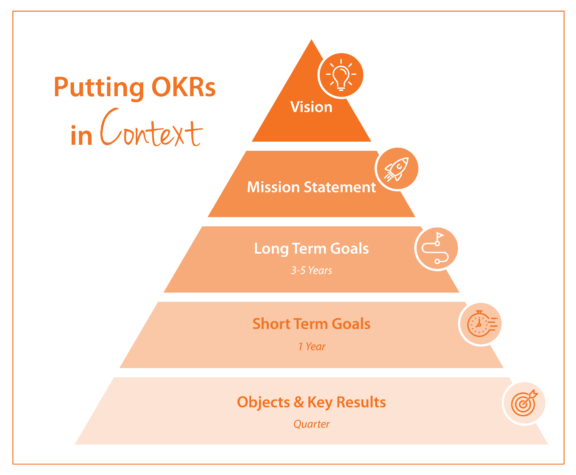
A company’s vision statement outlines the impact the business wants to have on the world. What will long-term success look like? This should be an inspirational ideal. The mission statement is a little more down-to-earth. It describes the actions the company will take to achieve its larger vision.
Once you understand the vision and the mission, it gets easier to define the smaller, time-bound goals that go into them. The magic of OKRs is that everything begins with the end in mind. In other words, all goals should help you work toward your overarching vision.
When you’re ready to roll out OKRs for the first time, start with these steps:
- Train leaders to ensure everyone understands the company’s mission, vision, and long-term goals.
- Brainstorm company OKRs that align with your plan for the coming fiscal year.
- Collaborate with managers to draft their first set of departmental OKRs.
- Communicate the OKR methodology to the entire company. This is a great opportunity for training and team building!
- Employees draft their individual OKRs.
- Managers review employees’ OKRs, give feedback, and make changes as needed.
- Finalize company-wide OKR alignment.
- Set and follow a clear schedule to monitor progress throughout the quarter.
Download 45 OKR Examples
Writing OKRs isn’t easy. Leaders need to strike a balance between dreaming big and setting achievable goals. You want to inspire your team with ambitious goals, not pressure them to do the impossible. Download our free list of 45 OKR examples to get started!










